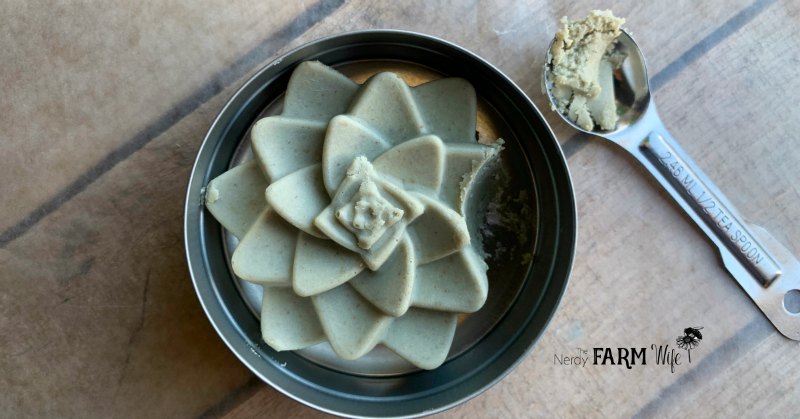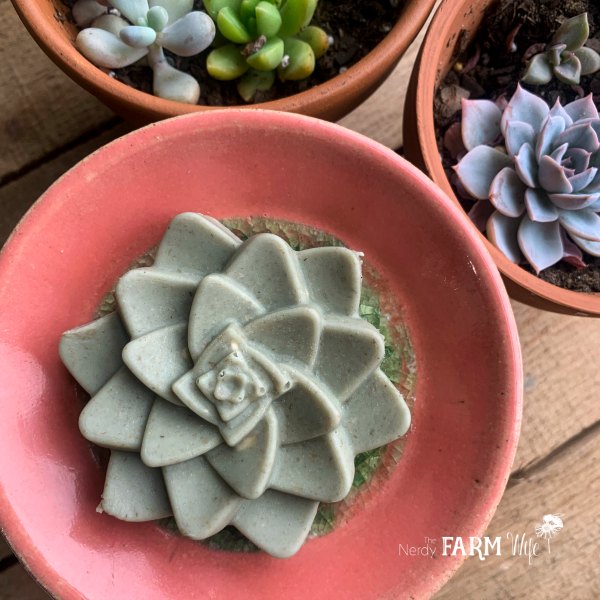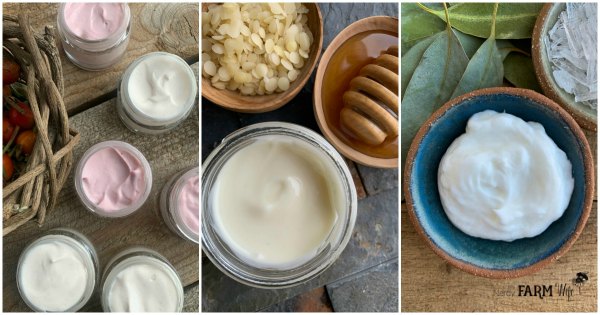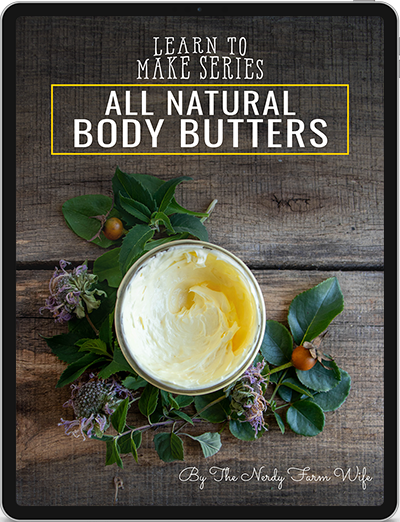Clay Cleansing Bars (Soap Free)
These natural clay cleansing bars are made with nourishing butters, oils, clay, and oatmeal, and are best suited for normal to dry skin.

I started working on this clay cleansing bar recipe a while back, and after quite a few experiments fine-tuning the amount of oils, butters, and clay, I finally settled on a ratio of ingredients that my skin likes.
The recipe is incredibly adaptable and open to a variety of substitutions.
Feel free to use whatever type of clay you like best. Some good gentle choices include rose clay, Cambrian blue clay, and yellow French or yellow Brazilian clay.
If you find that the cleansing bar is not quite right for your skin, you can always chop the finished bar up and melt it down again, adding more clay (for a more drying/cleansing effect), more oats (for exfoliation), more oil (for less drying effect), and/or more butter (for a harder bar.)

How to Make Clay Cleansing Bars
You’ll need a scale to weigh out the ingredients. I use and love a Jennings JSR-200 Scale I bought from Lotion Crafter.
The adorable succulent mold came from Bramble Berry and the 4 oz tins are from Specialty Bottle.
Ingredients Needed
- 40 g (1.41 oz) white kaolin clay
- 18 g (0.6 oz) powdered/ground oats*
- 1 g (1/2 tsp) alfalfa powder (optional, for color & a nutrient boost)
- 30 g (1.06 oz) cocoa butter
- 15 g (0.52 oz) aloe butter (or another soft butter such as shea, avocado)
- 12 g (0.42 oz) oil of your choice ** (I used cucumber seed oil)
- optional – 1 tsp (3.5 g) Phytocide Elderberry OS *** (oil soluble natural preservative)
Yield: one 4-ounce clay cleansing bar (or two 2-ounce bars)

Directions
Weigh the cocoa butter, aloe butter, oil of your choice, and alfalfa powder into a heatproof jar or container.
Place the jar down into a small saucepan containing a few inches of water, forming a makeshift double boiler.
Place the pan over a medium-low burner to heat.
Once the butters are melted, thoroughly stir in the Phytocide Elderberry OS, if using.
Next, stir in the clay and powdered oats.
Mix well and remove from heat.
Spoon the hot mixture immediately into a silicone mold, or molds.
To help you get a smoother look in more detailed molds like the one I used, spoon a little bit of the hot clay mixture in the bottom of the mold, then firmly rap the mold against the table to help the mixture settle into all of the crooks and crannies. Repeat this a few times before completely filling to the top.
Place the mold in your refrigerator for a few hours, or until the bar is completely cool and hardened.
Remove and transfer to a tin or other storage container.
* To make your own powdered oats for this recipe, just run regular oats through a coffee grinder until finely powdered.
** Use your favorite carrier oil for this recipe, such as sunflower, jojoba, sweet almond, apricot kernel, sesame, hemp, etc.
*** Phytocide Elderberry OS is a naturally derived preservative that can be used in oil based scrubs and products to help extend shelf life. It’s heat tolerant up to 167°F (75°C), so it can be safely added while everything is still melty and easy to stir.
While this recipe doesn’t contain water & doesn’t need a preservative as is, if you think it might come in contact with water during use, it’s a good idea to add one, as an extra assurance.
If you don’t want to worry about preservatives, you can just cut off small bits from the bar at a time and keep it stored in an airtight container between uses, so it never gets exposed to water.
How to Use a Clay Cleansing Bar
Butter and oil-based types of clay cleansing bars, like this one, work similar to the oil cleansing method.
- Break a small chunk off of the bar.
- Splash your face with warm water.
- Gently rub the piece of cleansing bar over your damp skin.
- Continue rubbing as it disintegrates over your skin.
- Take a washcloth and run very warm/hot water over it.
- Wring out the washcloth and immediately lay it over your face for a few moments.
- Remove the washcloth.
- Rinse your face using a combination of comfortably warm water and the washcloth until it’s clean.
- Follow with your favorite lotion.

Are you interested in making natural lotions and creams for you and your family?
Confused about preservatives and emulsifiers options?
If so, my Handmade Lotions & Creams eBook Collection was made just for you!



Thank you for sharing this Jan. I look forward to trying it out. Your coconut milk shampoo bars are fab. I made my first batch a couple of months ago :)
Hi Sasha, I’m so happy to hear that you’re enjoying the coconut milk shampoo bars! I hope you enjoy this recipe as well! :)
Hi Jan! I want to know if I can use this soap to wash my face.
I was looking your course about soaps, do you have recipes for different types of skin face?
Thanks
Diana
Hi Diana! This isn’t a soap, though it definitely looks like one! This is a soap-free cleanser that works using the same principles of the oil cleansing method. Crunchy Betty has a great article on the benefits of that: https://crunchybetty.com/oil-cleansing-method/
I use it to wash my face and throat at night, and you could also use it as an overall cleanser if you’d like.
If you’re looking to make cold process facial soaps, then you might enjoy my Natural Facial Soaps ebook. You can find it listed on this page: :)
https://thenerdyfarmwife.com/soap-books-resources-a-la-carte/
So what is the advantage of this over a regular soap bar?
Hi Connie! This uses the theory behind the oil cleansing method: https://crunchybetty.com/oil-cleansing-method/ but just has a boost of extra cleansing with the clay, and some exfoliation with the oats.
So for those who don’t do well with a regular soap cleanser, they might enjoy this cleansing method instead. I rarely use soap on my own face (I’m a big fan of honey face wash!), but this feels really nice on my skin too! :)
I just made this recipe today using Spirulina powder instead of alfalfa powder, mango butter, and sweet almond oil. What a luxurious face cleanse! Super easy and quick to make. Now whenever I feel like a mini spa break I’ll just reach for these! Thanks for the great recipe as always.
Hi Holly! Yay! I’m so glad you like the recipe! :)
Hello I am going to try making this recipe. Thank you for sharing! I would like to add some essential oils. How many drops would you recommend for this recipe?
Hi Kathleen! This makes 4 ounces of product, and I would aim for about a 0.5% dilution rate (if it’s for facial purposes).
So, that would be 12 drops of essential oil.
Here’s my essential oil dilution rate chart + suggested usage rates for skincare, if you want to tinker with the amounts. :)
https://thenerdyfarmwife.com/eo-dilution-chart-skincare/
Wasn’t sure where to leave this question as it pertains to a different one of your creations! I totally love your Simple and Natural Soapmaking book. I am having so much fun studying the recipes and techniques. Regarding the lavender milk bath bars on page 79. The shade of purple is gorgeous and I have not been able to find a purple Brazilian clay that looks like it will produce that color! I realize the recipe also has white kaolin clay in it. Wondering where you purchased the purple Brazilian clay. Thank you so much for your wonderful books and your advice.
Warm Regards,
Ina Peebles
Hi Ina! I’m so happy to hear you like the book! :) I used the purple Brazilian clay from Bramble Berry, along with their white kaolin clay – it’s a very pure white color which helps the clay’s purple color really stand out! I’ve bought some kaolin clays that are labeled as white before, but they turned out to be more brown or gray and give the color a dingier tone, so look for the whitest clay you can find and also use the lightest colored oils (no extra virgin or anything yellow-green or green as that will muddy the color.) I hope that helps & I’d love to hear how it goes! :)
Can you use this on daily basis?
Hi Poornima! It depends on your skin type – my skin tends to be dry, so I use it about once or twice a week. You could experiment and see what works best for your skin! :)